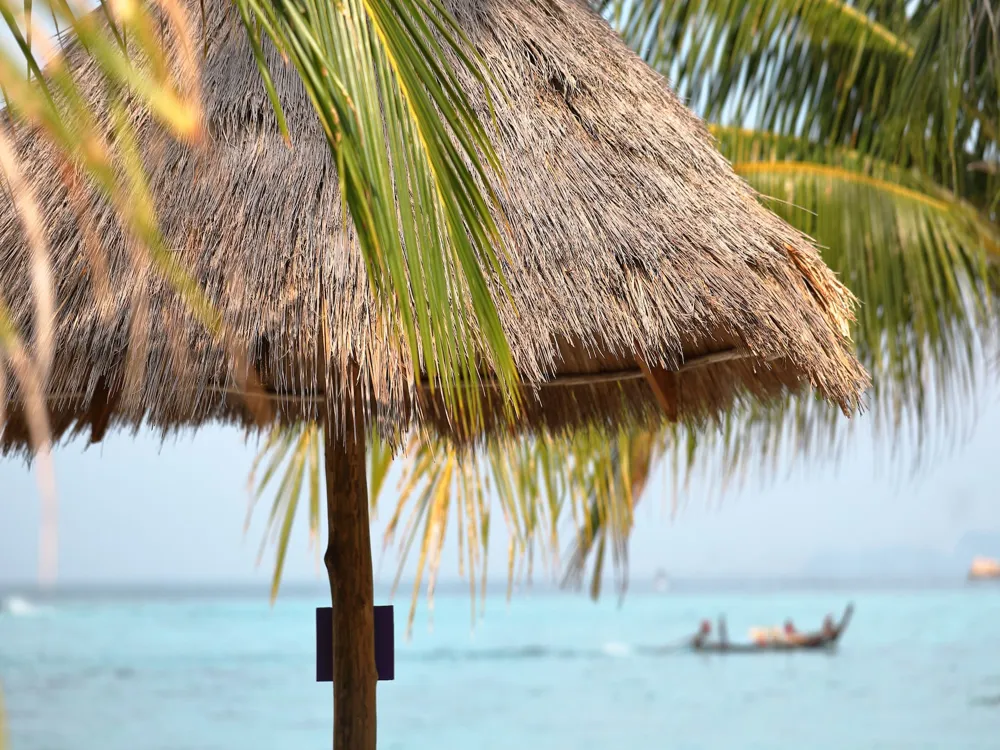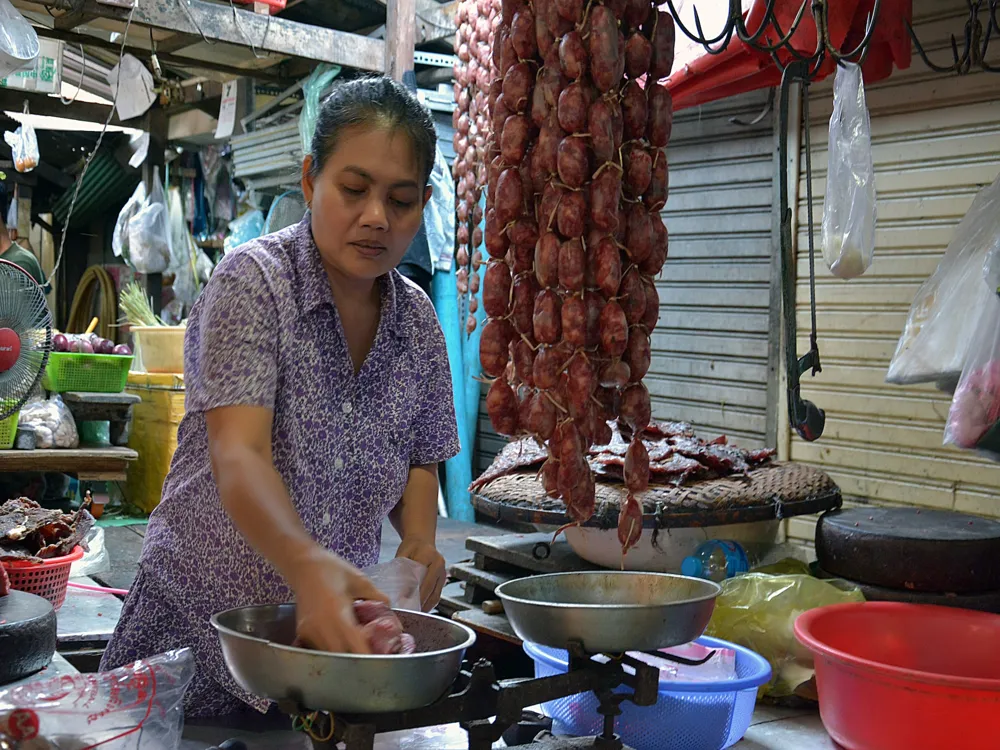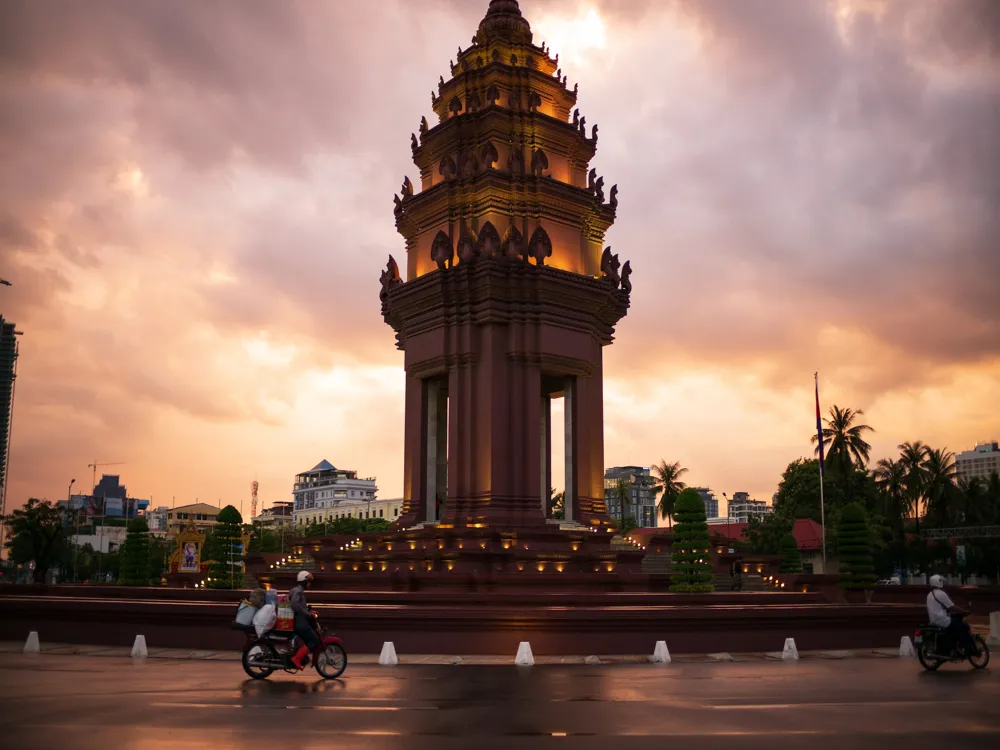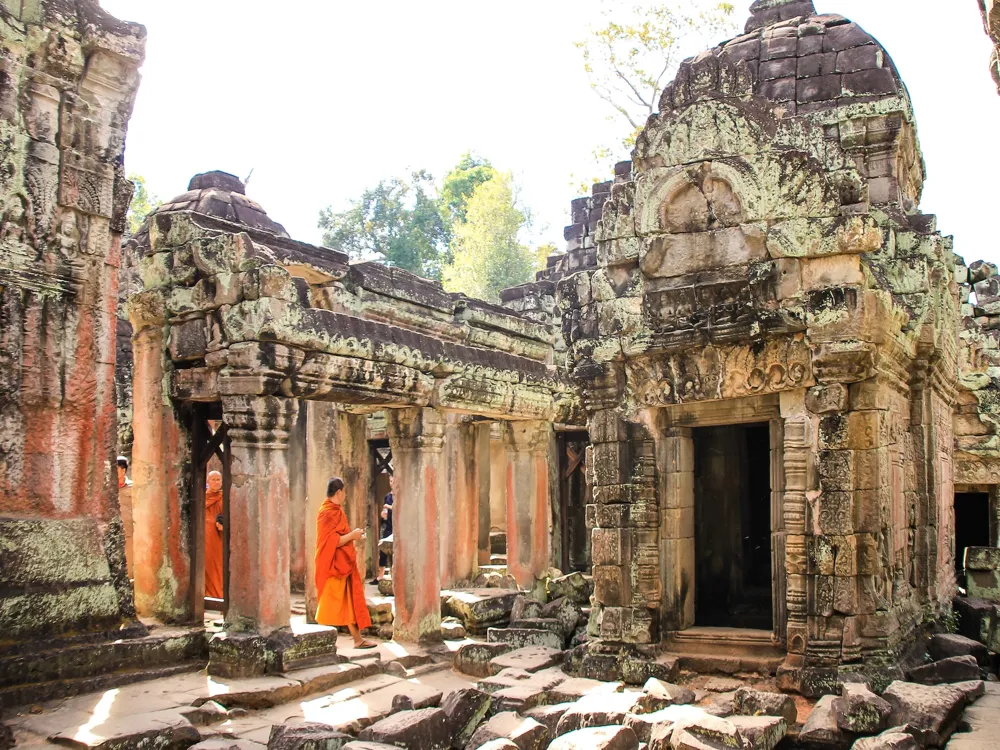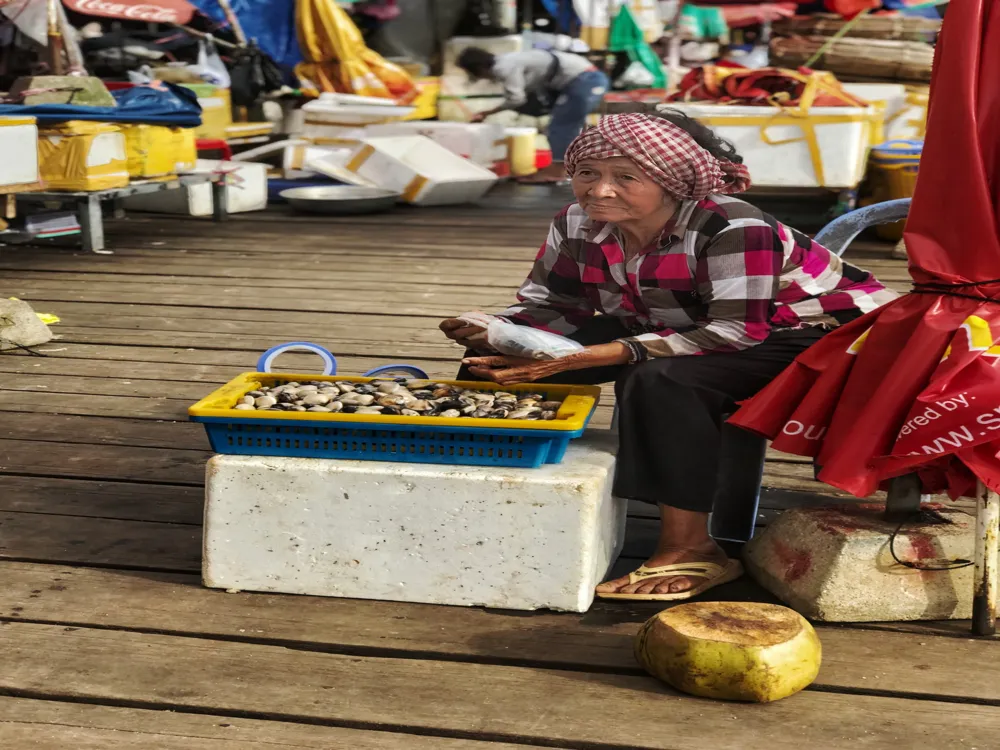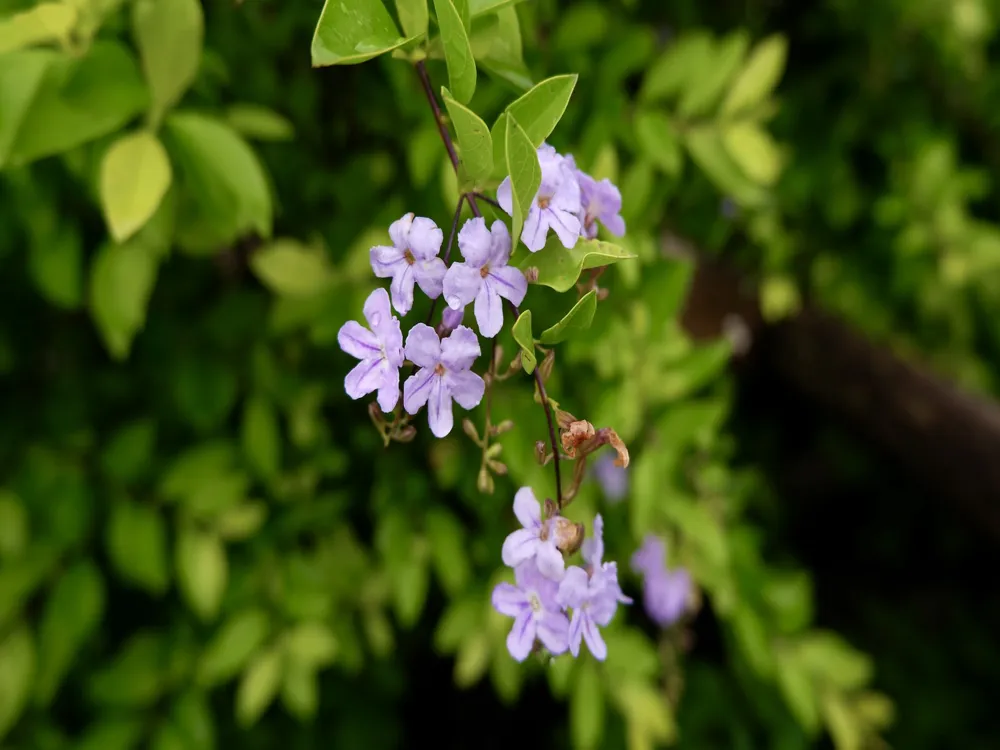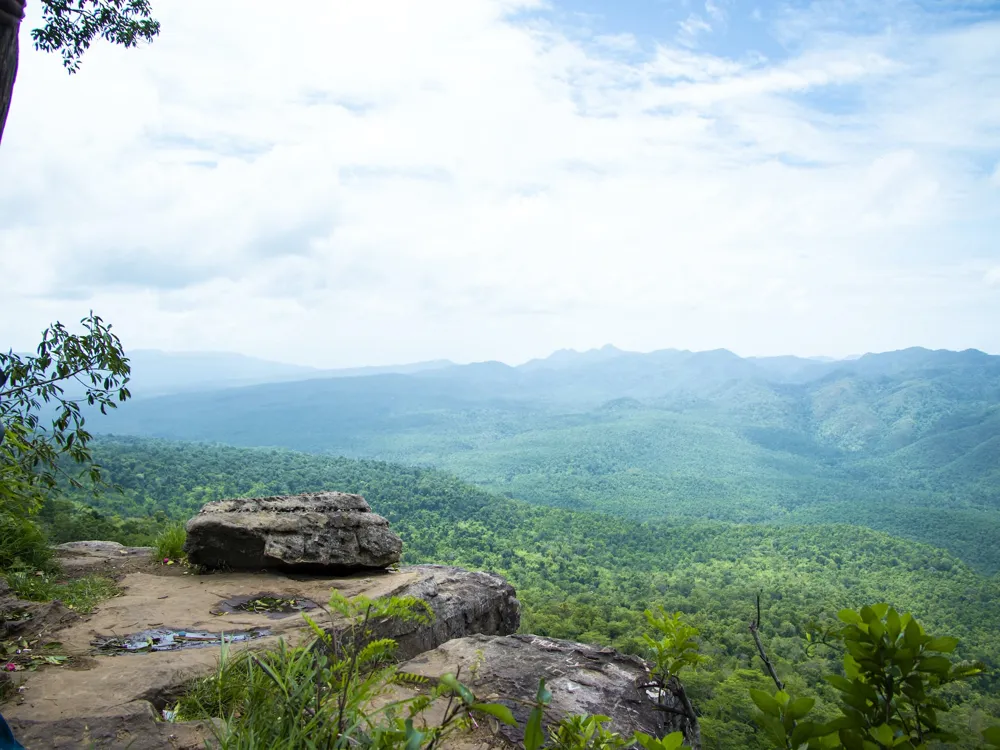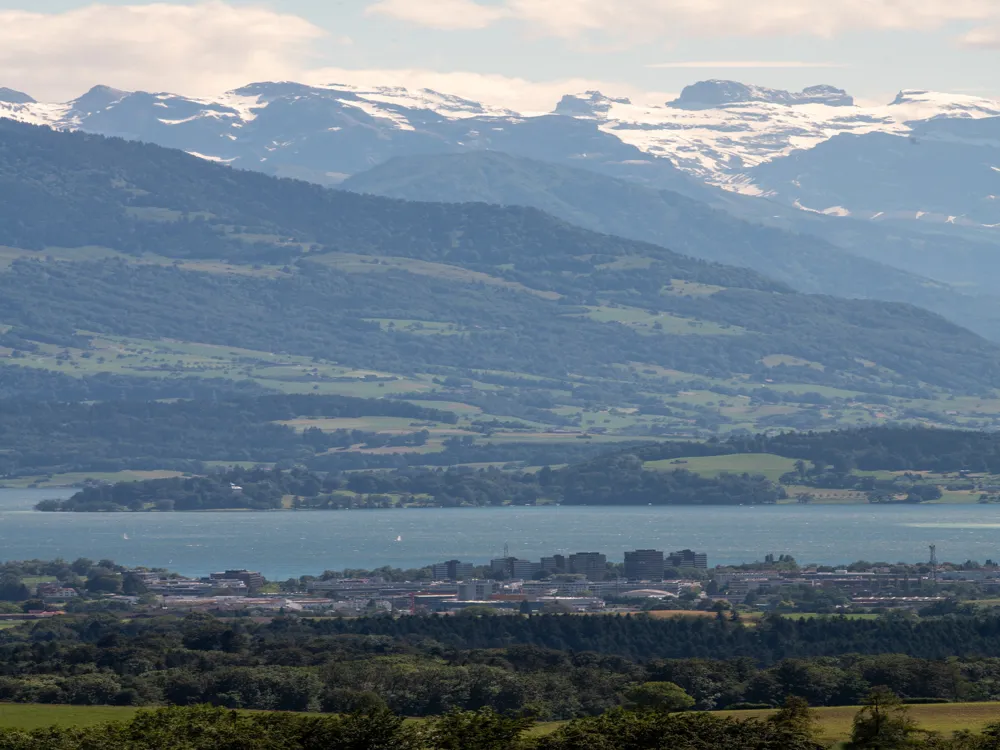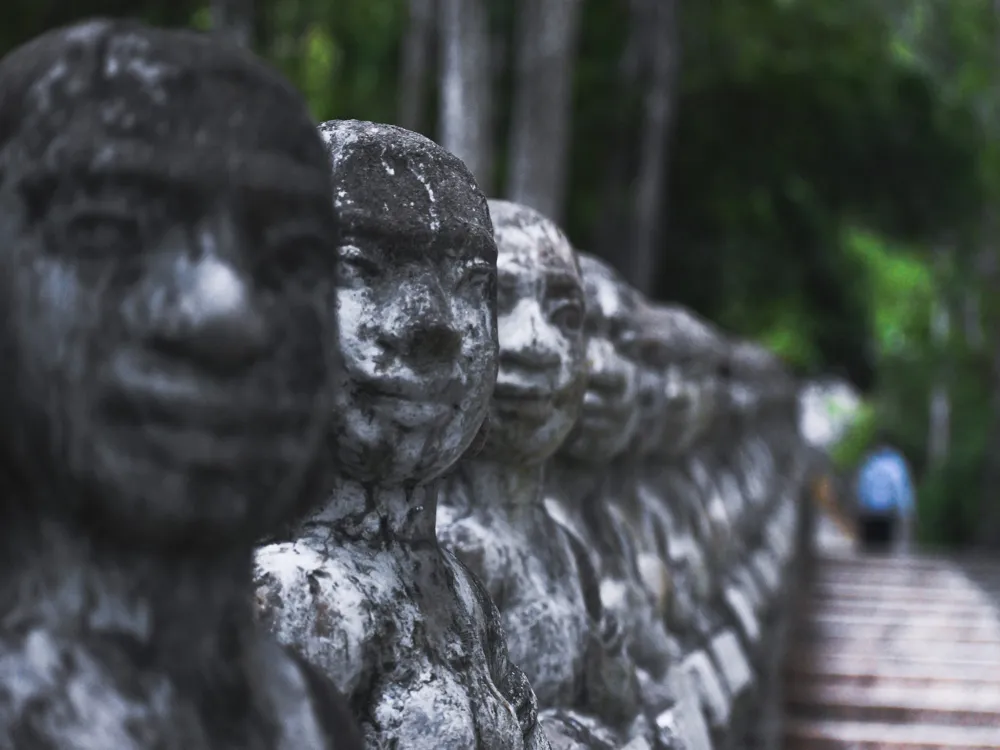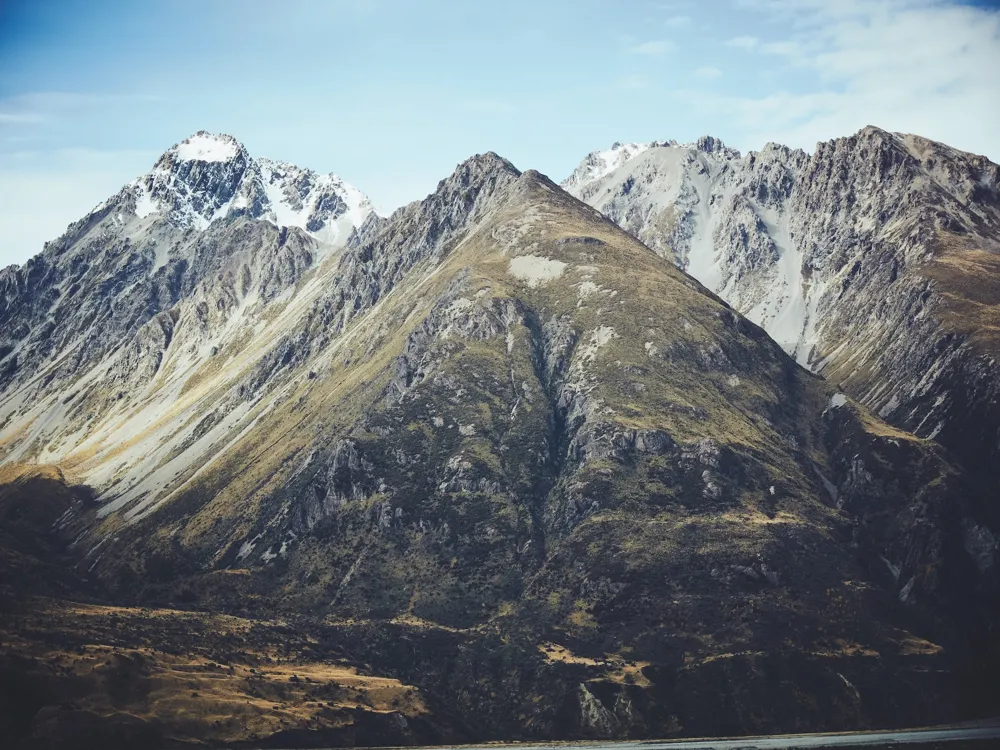Phnom Sombok is a fascinating and spiritually significant site located in the Kratie province of Cambodia. This serene and picturesque locale is perched atop a hill and offers a peaceful retreat from the hustle and bustle of city life. The charm of Phnom Sombok lies in its natural beauty and the spiritual ambiance that it exudes, making it a must-visit destination for those seeking tranquility and a deeper understanding of Cambodian culture and heritage. The history of Phnom Sombok dates back centuries, intertwining with the rich tapestry of Cambodian history. This sacred site has been a center of Buddhist worship and pilgrimage for many years, attracting visitors from all corners of the country and beyond. The name 'Phnom Sombok' itself is derived from the Khmer language, where 'Phnom' means 'hill' or 'mountain' and 'Sombok' is believed to signify 'bundle' or 'collection', which could metaphorically represent a gathering of spiritual beliefs and practices. As visitors ascend the hill, they are greeted by a winding path surrounded by lush greenery, creating an atmosphere of calm and serenity. The journey to the top, though mildly strenuous, is part of the experience, allowing visitors to immerse themselves in the natural beauty and tranquility of the surroundings. Along the way, one can witness a variety of flora and fauna, which adds to the charm of Phnom Sombok. The top of Phnom Sombok offers breathtaking views of the surrounding landscape, including the mighty Mekong River, which flows gracefully nearby. This panoramic vista is a photographer's delight and provides a perfect backdrop for some introspection and meditation. The gentle breeze at the summit further enhances the sense of peace and calm that envelops this sacred site. Phnom Sombok is not just a natural wonder but also a repository of cultural and spiritual significance. The site is home to several stupas, statues, and shrines that are deeply revered by the local Buddhist community. These structures are not only religious symbols but also artistic masterpieces, showcasing the exquisite craftsmanship and architectural prowess of the Cambodian people. One of the most striking features of Phnom Sombok is the presence of numerous monkey families that have made the hill their home. These monkeys are relatively tame and coexist peacefully with the monks and visitors. They add an element of playfulness and charm to the serene environment, although visitors are advised to be cautious with their belongings, as the monkeys can be quite curious and mischievous. The spiritual ambiance of Phnom Sombok is further amplified by the presence of Buddhist monks who reside in the small monastery located on the hill. These monks lead a life of simplicity and devotion, following the teachings of Buddha. They are often seen meditating, chanting, or engaging in daily rituals, which adds to the sacred atmosphere of the site. Visitors have the opportunity to interact with these monks, learn about their way of life, and even participate in certain rituals and ceremonies, making the experience at Phnom Sombok truly unique and enriching. Phnom Sombok is not only a destination for spiritual seekers but also for those interested in learning about Cambodian culture and history. The site serves as a living museum, offering insights into the country's religious practices, architectural styles, and artistic expressions. The peaceful coexistence of nature, spirituality, and cultural heritage at Phnom Sombok makes it a microcosm of Cambodian society and an embodiment of the country's soul. In conclusion, Phnom Sombok stands as a beacon of spirituality, culture, and natural beauty in Cambodia. It offers a tranquil escape for those looking to connect with nature and explore the depths of Cambodian heritage. Whether it's for meditation, photography, cultural exploration, or simply a peaceful retreat, Phnom Sombok is a destination that promises a rich and fulfilling experience. The architecture of Phnom Sombok is a splendid representation of Cambodian religious and cultural heritage. This revered site showcases a blend of traditional Khmer architectural elements with Buddhist motifs, creating an ambiance that is both spiritual and aesthetically pleasing. The architectural features of Phnom Sombok are not just mere structures; they are embodiments of religious beliefs, historical events, and artistic expressions that have evolved over centuries. The most striking aspect of Phnom Sombok's architecture is its harmonious integration with the natural surroundings. The hill on which it is situated provides a natural elevation, making the site a commanding presence in the landscape. The structures are built in a way that complements the hill's contours, creating a seamless blend of man-made and natural beauty. This integration is a testament to the Cambodian people's respect for nature and their ability to create architectural wonders that enhance rather than dominate the natural environment. One of the key architectural features of Phnom Sombok is the stupa, a dome-shaped structure that is a common sight in Buddhist temples across Asia. The stupas at Phnom Sombok are intricately decorated with carvings and motifs that depict various aspects of Buddhist teachings and Cambodian history. These stupas serve as reliquaries, housing sacred relics and offering a space for meditation and prayer. The pagoda or vihara is another significant architectural element of Phnom Sombok. These structures are beautifully adorned with carvings, sculptures, and murals that depict scenes from the life of Buddha and other religious narratives. The pagodas are not just places of worship; they are also centers of learning, where monks and laypeople alike come to study Buddhist teachings and engage in spiritual practices. The architecture of Phnom Sombok is characterized by the use of vibrant colors, with reds, golds, and greens being predominant. These colors are not just aesthetically pleasing but also carry symbolic meanings. Red symbolizes bravery and strength, gold represents wisdom and enlightenment, and green signifies tranquility and harmony with nature. The use of these colors in the structures creates a visually stunning and spiritually uplifting environment. Sculptures and statues are another integral part of Phnom Sombok's architecture. These statues, often made of stone or bronze, represent various deities, saints, and mythological figures from Buddhist and Hindu traditions. The craftsmanship of these sculptures is remarkable, with attention to detail and artistic finesse that reflect the skilled artisans' dedication and devotion. The architecture of Phnom Sombok also includes intricately carved gates and doorways, which serve as transitional spaces between the mundane world and the sacred realm. These gates are often adorned with guardian figures and mythological creatures, symbolizing the protection of the sacred space from negative influences. The elaborate designs of these gates are a visual feast and set the tone for the spiritual journey that awaits visitors inside. In addition to the religious and artistic aspects, the architecture of Phnom Sombok also demonstrates an understanding of environmental factors. The placement of structures, the orientation of windows and doors, and the use of natural light and ventilation are all carefully considered to create a comfortable and harmonious environment for worship and meditation. In conclusion, the architecture of Phnom Sombok is a magnificent showcase of Cambodian heritage, reflecting the country's religious beliefs, artistic traditions, and respect for nature. It is a testament to the skill and devotion of the Cambodian people, who have created a space that is not only visually stunning but also spiritually profound. The architectural wonders of Phnom Sombok continue to inspire and awe visitors, making it a treasured landmark in Cambodia's cultural landscape. When visiting Phnom Sombok, it's important to dress modestly out of respect for the religious and cultural norms. This means covering shoulders and knees, and avoiding overly revealing clothing. Light, breathable fabrics are recommended due to the warm climate. The hill is home to many monkeys, which are generally harmless but can be mischievous. Keep a close eye on your belongings, avoid feeding them, and maintain a respectful distance to prevent any unwanted interactions. Visitors should always show respect to the monks and the religious practices occurring at Phnom Sombok. This includes speaking softly, not interrupting prayers or ceremonies, and asking permission before taking photographs, especially of people. The climb to the top of the hill can be tiring, especially in the heat. It's crucial to stay hydrated and protect yourself from the sun with hats, sunscreen, and sunglasses. Consider hiring a local guide to gain deeper insights into the history, architecture, and religious significance of Phnom Sombok. Guides can provide valuable information that enhances the overall experience. The ascent to the top of Phnom Sombok involves a fair amount of walking, often on uneven terrain. Wear comfortable shoes and be prepared for a moderate physical challenge. Reaching Phnom Sombok is a journey that adds to the overall experience of visiting this serene and spiritual site. Located in the Kratie province of Cambodia, it is accessible by various means of transportation, depending on your starting point and preferences. For those traveling from Phnom Penh, the capital city of Cambodia, the journey to Kratie can be made by bus, taxi, or private car. The distance is approximately 250 kilometers, and the journey typically takes around 5-6 hours, depending on traffic and road conditions. Buses are a popular and affordable option, with several companies offering daily services to Kratie. Taxis and private cars offer more flexibility and comfort but are relatively more expensive. Upon reaching Kratie town, Phnom Sombok is only a short distance away. Local transportation options such as tuk-tuks or motodops (motorcycle taxis) are readily available to take visitors to the base of the hill. These local transports provide a unique and authentic Cambodian experience, and the drivers often serve as informal guides, sharing interesting information about the area. For those seeking a more adventurous route, renting a bicycle or motorbike in Kratie town and riding to Phnom Sombok is an excellent option. This not only gives visitors the freedom to explore at their own pace but also allows them to enjoy the scenic countryside and interact with local communities along the way. It's important to note that the road conditions in some areas might be challenging, and it's advisable to check the route and weather conditions before embarking on the journey. Additionally, for international travelers, it's important to have the necessary travel documents and understand the local traffic laws and customs. In conclusion, reaching Phnom Sombok is an integral part of the experience, offering a glimpse into the beauty and diversity of Cambodia's landscapes and cultures. Whether by bus, taxi, tuk-tuk, or bicycle, the journey to this sacred hill is sure to be a memorable one. Read More:Overview of Phnom Sombok in Kratie
Architecture of Phnom Sombok
Tips When Visiting Phnom Sombok
Dress Appropriately
Be Mindful of Monkeys
Respect the Monks and Religious Practices
Stay Hydrated and Protected from the Sun
Explore with a Guide
Be Prepared for the Climb
How To Reach Phnom Sombok
Phnom Sombok
Kratie
NaN onwards
View kratie Packages
Weather :
Tags : Temple
Timings : 6 AM to 6 PM
Time Required : 45 minutes to 1 hour
Planning a Trip? Ask Your Question
Kratie Travel Packages
View All Packages For Kratie
Top Hotel Collections for Kratie

Private Pool

Luxury Hotels

5-Star Hotels

Pet Friendly
Top Hotels Near Kratie
Other Top Ranking Places In Kratie
View All Places To Visit In kratie
View kratie Packages
Weather :
Tags : Temple
Timings : 6 AM to 6 PM
Time Required : 45 minutes to 1 hour
Planning a Trip? Ask Your Question
Kratie Travel Packages
View All Packages For Kratie
Top Hotel Collections for Kratie

Private Pool

Luxury Hotels

5-Star Hotels

Pet Friendly








